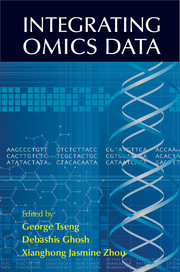Book contents
- Frontmatter
- Contents
- Contributors
- Introduction
- Part A Horizontal Meta-Analysis
- Part B Vertical Integrative Analysis (General Methods)
- Part C Vertical Integrative Analysis (Methods Specialized to Particular Data Types)
- 12 eQTL and Directed Graphical Model
- 13 MicroRNAs: Target Prediction and Involvement in Gene Regulatory Networks
- 14 Integration of Cancer Omics Data into a Whole-Cell Pathway Model for Patient-Specific Interpretation
- 15 Analyzing Combinations of Somatic Mutations in Cancer Genomes
- 16 A Mass-Action-Based Model for Gene Expression Regulation in Dynamic Systems
- 17 From Transcription Factor Binding and Histone Modification to Gene Expression: Integrative Quantitative Models
- 18 Data Integration on Noncoding RNA Studies
- 19 Drug-Pathway Association Analysis: Integration of High-Dimensional Transcriptional and Drug Sensitivity Profile
- Index
- Color plates
14 - Integration of Cancer Omics Data into a Whole-Cell Pathway Model for Patient-Specific Interpretation
from Part C - Vertical Integrative Analysis (Methods Specialized to Particular Data Types)
Published online by Cambridge University Press: 05 September 2015
- Frontmatter
- Contents
- Contributors
- Introduction
- Part A Horizontal Meta-Analysis
- Part B Vertical Integrative Analysis (General Methods)
- Part C Vertical Integrative Analysis (Methods Specialized to Particular Data Types)
- 12 eQTL and Directed Graphical Model
- 13 MicroRNAs: Target Prediction and Involvement in Gene Regulatory Networks
- 14 Integration of Cancer Omics Data into a Whole-Cell Pathway Model for Patient-Specific Interpretation
- 15 Analyzing Combinations of Somatic Mutations in Cancer Genomes
- 16 A Mass-Action-Based Model for Gene Expression Regulation in Dynamic Systems
- 17 From Transcription Factor Binding and Histone Modification to Gene Expression: Integrative Quantitative Models
- 18 Data Integration on Noncoding RNA Studies
- 19 Drug-Pathway Association Analysis: Integration of High-Dimensional Transcriptional and Drug Sensitivity Profile
- Index
- Color plates
Summary
Abstract
Recent surveys of multiple types of cancer reveal that most tumors are composed of populations of different cells with distinct sets of mutations. The variety of such subclones are thought to fuel drug resistance – targeting any single gene or pathway nearly always selects for those sub-clones lucky enough to have evolved backup mechanisms. The picture for treating cancer is thus becoming more clear: treating one cancer means keeping an entire population of cells in check. One angle, based on the principles of combinatorics that has worked in treating HIV for example, is to target multiple pathways simultaneously to better the chances of eliminating every malignant cell in the population. However, this approach requires gene regulatory network models that accurately describe the causes underlying tumor cell fitness.
This chapter overviews computational representations of genetic pathways for capturing salient aspects of tumor biology such as the activation of key genes and processes, how mutations confer gain- or loss-of-function in their cognate genes, and whether explanatory subnetworks can be identified for specific subtypes of disease. Pathway modeling provides a much-needed theoretical foundation to postulate tumor vulnerabilities that can scale to the consideration of multiple targets. Advances in the development of such mathematical frameworks should aid the clinical application of patient-specific treatments that minimize or eliminate malignant cell populations.
Introduction
Cancer genomics utilizes a wide variety of data types on individual tumors. Microarrays have been used to profile genome copy number, gene expression, DNA methylation, and more. Profiling of DNA mutations, DNA breakpoints, gene fusions, RNA expression, and RNA editing are now becoming routine. These techniques have established that even though cancer is a genomically driven disease, any one type of genomic alteration is not enough to explain the altered be haviors and transcriptional states of various tumors. Drivers genes cluster into groups of biochemically interacting genes, and individual tumors often have a mutation in just one of the genes in the cluster. For example, PIK3CA or its suppressor PTEN is mutated in tumor samples far more frequently than expected, but samples with both mutations are far less frequent than expected. A full understanding of the diversity and pattern of mutations and abnormal regulation in cancer therefore requires integration of data types and the cellular network.
Information
- Type
- Chapter
- Information
- Integrating Omics Data , pp. 310 - 336Publisher: Cambridge University PressPrint publication year: 2015
